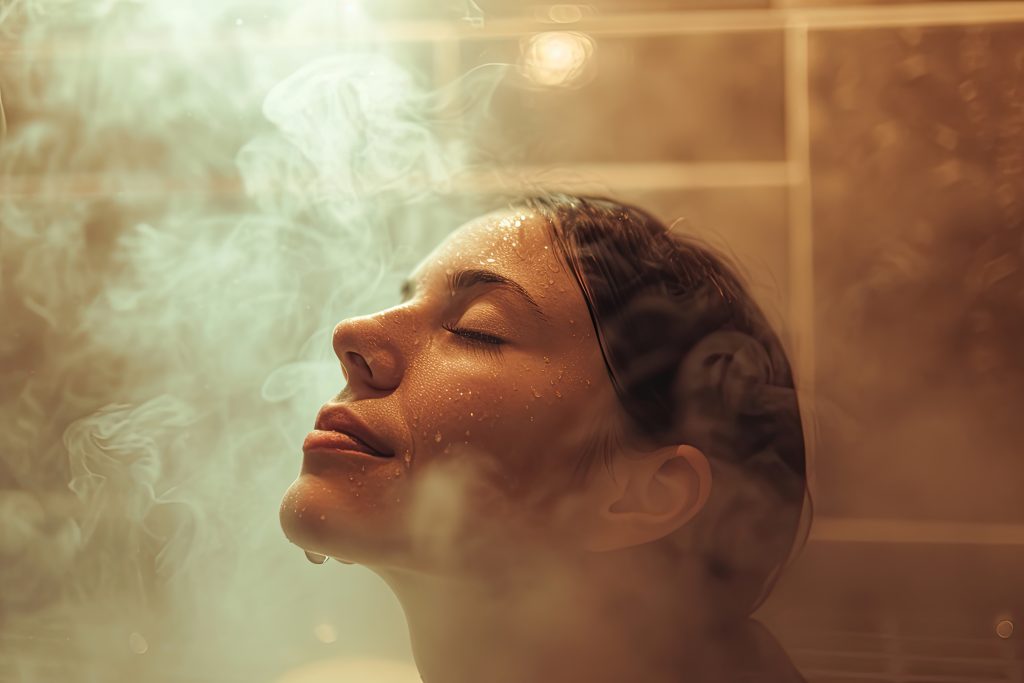
Steam therapy, also known as steam bathing or thermotherapy, has been a healing practice for thousands of years. Its roots trace back to ancient civilisations that used steam to promote health, relaxation, and spiritual well-being.
Ancient civilisations and cultures
The Ancient Egyptians used steam for physical and spiritual cleansing, as well as for purification rituals. Perhaps the most famous ancient users were the Romans who developed elaborate thermae (public bathhouses) baths, which were the cornerstone of Roman society promoting not just cleanliness but socialisation and relaxation.
Derived from Roman bathhouses, the Turkish hammam is a key part of Middle Eastern culture for spiritual cleansing, rejuvenation, and socialising. Native Americans used sweat lodges for similar purposes and still do – although with more emphasis on mind-body connections.
Today, steam therapy has expanded globally and is often a core relaxation activity in spas, gyms, and wellness centres. Modern steam rooms offer a controlled environment of moist heat, usually set between 43-46°C (110-115°F), combining ancient traditions with modern technologies for therapeutic benefits and to decompress.

Physical health benefits of steam therapy
Steam therapy offers a wide range of physical health benefits, many of which are backed by modern science. Here are some key advantages:
Respiratory health:
- Sinus and nasal relief: Steam helps to open nasal passages, reducing congestion and easing breathing. This makes steam therapy effective for people with colds, sinusitis, or allergies. Inhaling steam can help to alleviate congestion and soothe throat irritation.
- Bronchial support: Inhaling warm, moist air can help soothe bronchial irritation and loosen mucus in the lungs, which is beneficial for conditions like asthma or bronchitis.
- Pulmonary benefits: Some studies suggest that regular use of steam baths can help improve lung function by dilating airways and promoting better oxygen exchange.
Skin health:
- Detoxification: Steam helps the skin to release toxins through perspiration. It opens pores, which allows for deep cleansing and can prevent acne and blackheads. Additionally, salt particles in steam can enhance detoxification and skin health by penetrating deeply into the skin.
- Improved skin hydration: Moist heat helps to hydrate dry skin and improve elasticity, giving skin a smoother, rejuvenated appearance. Salt inhalation also benefits skin hydration and overall skin health by promoting better moisture retention.
- Exfoliation: When combined with exfoliation treatments, steam helps to remove dead skin cells, promoting cell regeneration and a youthful glow.
Cardiovascular benefits:
- Improved circulation: The warm, moist atmosphere stimulates blood vessels to expand, improving blood flow throughout the body. This can enhance oxygen delivery to muscles and tissues.
- Heart health: Studies suggest that regular steam or sauna therapy can lower blood pressure, reduce arterial stiffness, and lower the risk of cardiovascular diseases like stroke and heart attacks.
Muscle recovery:
- Easing muscle pain: The heat from steam therapy helps to relieve tension in muscles and joints, making it an excellent post-workout or injury recovery tool.
- Anti-inflammatory effects: Steam therapy is thought to reduce inflammation in the body, which can help with arthritis, muscle soreness, and other inflammatory conditions.
Boosts immunity:
- Enhanced white blood cell production: Steam can stimulate the production of white blood cells, which helps to enhance the body’s immune response and fight off infections more effectively.
- Fever simulation: Steam can induce an artificial fever, promoting the body’s natural immune response. This is particularly helpful in fighting off early-stage infections.
Mental health benefits of steam therapy
While the physical benefits are well-known, steam therapy can also offer profound mental and emotional benefits, such as stress reduction, improved sleep quality, and mental clarity:
Stress reduction:
- Relaxation of the mind: The warmth and quiet atmosphere of steam rooms help promote a sense of calm and reduce stress levels. It is a form of mindfulness therapy, where the focus is on the body’s sensations, promoting relaxation.
- Cortisol reduction: Studies show that exposure to steam and heat can reduce levels of cortisol, the stress hormone, which helps to relieve anxiety and improve mood.
Improved sleep quality:
- Deep relaxation: Steam therapy induces a state of relaxation, which helps people fall asleep faster and enjoy deeper sleep. Regular use can improve sleep patterns and aid in the treatment of insomnia.
- Melatonin regulation: Studies suggest that steam therapy might help regulate the body’s production of melatonin, which helps control the sleep-wake cycle.
Mental clarity:
- Cognitive boost: The increased circulation and oxygenation brought on by steam therapy may also contribute to better focus and mental clarity. Steam can clear mental fog and improve attention span.
- Endorphin release: The warm environment triggers the release of endorphins (feel-good hormones), enhancing mood and producing a sense of well-being.
Anxiety and depression management:
- Serotonin increase: Steam therapy is believed to promote the production of serotonin, the ‘happiness hormone’. Higher serotonin levels help combat depression and improve mood.
- Mindfulness and meditation: Many cultures incorporate mindfulness and meditative practices into steam therapy. The heat and solitude offer an excellent environment for calming the mind and practicing mindfulness, which can help manage symptoms of anxiety and depression.
How to use steam therapy
Steam therapy can be used in various forms, depending on your health needs and preferences. Steam rooms and saunas are common in gyms and spas. Typically, steam rooms operate at a lower temperature with higher humidity, while saunas use dry heat at higher temperatures. Both offer significant health benefits, but steam rooms are preferred for respiratory relief due to the moist air. Alternatively, you can practice steam therapy at home through simple steam inhalation methods or by installing a steam shower or steam room. Adding a few drops of essential oils or herbs to the steam can enhance its benefits. For example:
- Eucalyptus: Excellent for respiratory conditions like colds or asthma.
- Lavender: Soothes the mind and promotes relaxation.
- Camomile: Calms the skin and reduces irritation.
Using essential oils can provide additional health benefits, such as antibacterial activity and symptom relief. Steam inhalers are also beneficial for alleviating symptoms associated with colds, congestion, and other respiratory issues.
Safety considerations
While steam therapy offers many benefits, it is essential to practice safely. It stimulates fluid loss through sweating, so it is essential to drink water before and after the session to stay hydrated. You should also limit your time in steam rooms to 15–20 minutes per steam session to avoid negative physical reactions such as overheating or dehydration. People with cardiovascular issues, high blood pressure, or respiratory conditions like asthma should consult their doctor before using steam therapy regularly. Overall, this type of therapy is an age-old practice that offers a wealth of mental and physical health benefits. Whether you seek relaxation, improved skin health, respiratory relief, or mental clarity, steam therapy provides an accessible and effective way to promote overall well-being. However, like all therapies, it should be used responsibly.
Frequently asked questions
Is a steam room better for you than a sauna?
A steam room can be more beneficial than a sauna for individuals seeking respiratory relief, skin hydration, or gentler heat, as the high humidity helps open airways and moisturizes the skin. However, for those focused on muscle recovery, detoxification, and cardiovascular benefits, saunas may be more effective due to their higher temperatures and dry heat, which promote circulation and sweating. Ultimately, the benefits of each depend on personal health goals, and neither is universally better; it comes down to individual preference and specific health needs.
Can it help with my cough or sore throat?
Yes, a steam room can help relieve a cough or sore throat by adding moisture to the air, which soothes irritated airways and reduces throat dryness. The warm, humid environment may also loosen mucus, making it easier to expel and easing respiratory discomfort.
Will I lose weight in a steam room?
Steam therapy can contribute to temporary weight loss through water weight reduction as the body sweats in the humid heat. However, it doesn’t significantly burn fat, so lasting weight loss requires regular exercise and a healthy diet.

























